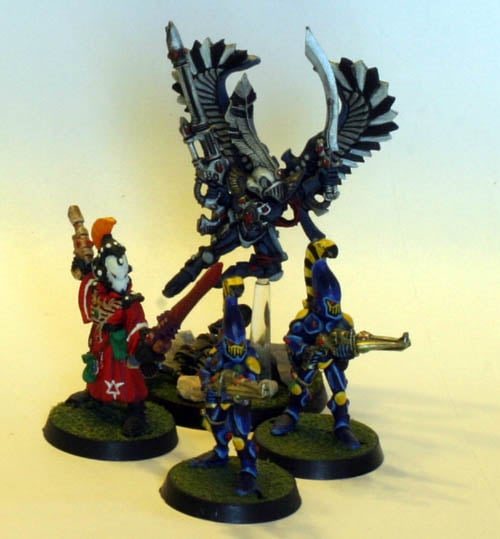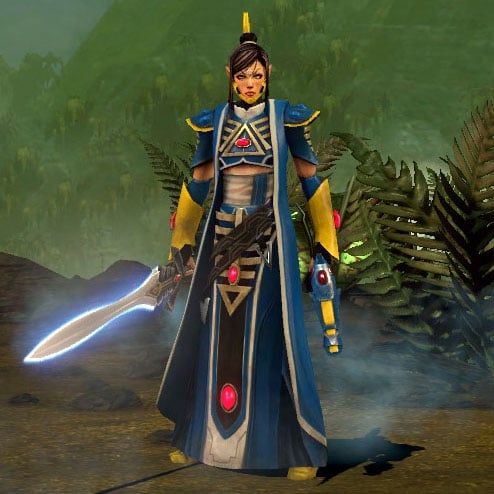40K TACTICS: Eldar Psychic Powers

Hey guys, I am Learn2Eel I’m here to start in on our analysis of Codex: Eldar. The Craftworlders are back with a vengeance.
Eldar – Psychic Powers
Psychic Powers
The children of Asuryan are psykers with few parallels in the galaxy, their endless training and refinement of innate psychic skills leading to some of the most focused and powerful beings of their kind. Eldar psychic powers are naturally geared more for support than anything else, with a heavy emphasis on blessings and maledictions above witchfires; given the availability of psychic defence and Deny the Witch, this is a passive boon that allows them to more readily influence the game without fear of denial. The Eldar have two distinct psychic trees available, with the Runes of Fate available to Farseers and Eldrad Ulthran only, while the latter Runes of Battle can be accessed by Warlocks and Spiritseers. Overall, I would say that Eldar have the strongest set of in-codex psychic powers, owing both to their natural support focus and with most of them providing some very useful and potentially game-changing benefits. Though the popular pick for many may still be Divination, the two psychic trees have some very strong powers.
Runes of Battle – Despite the name, this collection of psychic powers is actually more support focused than the Runes of Fate; the unique trait of these powers is the startlingly attractive duality of each power, with each one having a specific effect against enemies, and another against allies. This is a very strong psychic table with very few weak points, though it does heavily depend on which psyker – and by extension, which unit – rolls up any given psychic power. With no real way to control these, it certainly helps that the Primaris power is incredibly strong for almost any unit – a note that these are referred to as the ‘0’ power for the purposes of the review. All of the following powers are Warp Charge one, and as such any psyker in the codex that has access to this discipline may use them.
0) Conceal/Reveal – The first effect is a blessing that grants the psyker the Shrouded special rule, and owing to the wording of the rule, it is conferred on to their unit as well. Unless you play against a Noise Marine or Tau force, gaining a +2 bonus to cover saves is an incredible defensive boost for almost any unit; the few units that won’t benefit from it too much are those that either already have the rule or do not require the inclusion of a Warlock or Spiritseer anyway. The second effect is a malediction that removes the Stealth and Shrouded special rules from an enemy unit within eighteen inches. To put it lightly, this effectively grants the Eldar force a somewhat unreliable form of Night Vision to be used against a specific target, and is very useful for removing irritating units that feature these special rules – such as Stealth Suits and Striking Scorpions. Perhaps most amusingly, it is incredibly damaging for Nurgle Daemons, even if Eldar hate Slaanesh Daemons above all else.
1) Destructor/Renewer – The former power is the only witchfire power in the list and manifests as a heavy flamer with the soul blaze special rule, meaning it is very useful against all but the most elite of infantry. Between mediocre Leadership values and Deny the Witch, it is, unfortunately, unreliable. The latter power is a blessing with a range of eighteen inches that restores a single lost wound to a friendly model; though this won’t be of much use for a typical Eldar force, it is hilarious in an army that can feature Wraithknights, Wraithlords and the Avatar of Khaine.
2) Embolden/Horrify – The blessing part of this power makes the psyker and their unit Fearless, while the malediction part of the power reduces the Leadership of a single enemy unit within eighteen inches by a whopping score of three. The former won’t be of much use to a Wraith army, but will be highly useful otherwise to keep your fragile forces in the fight; the latter is incredibly synergistic with the amount of Fear-causing units in the codex, and particularly with the Hemlock Wraithfighter.
3) Enhance/Drain – Enhance provides the psyker and their unit with a bonus of one to both their Weapon Skill and Initiative; while the latter may be seen as unnecessary owing to the typically high Initiative values of all Eldar, the former is definitely a big improvement for any unit and is necessary to force through a greater number of hits and, consequently, wounds. The latter subsequently reduces the Weapon Skill and Initiative of an enemy unit within eighteen inches by one, which in some cases may actually be the more beneficial skill to use, particularly if you are trying to help another of your units.
4) Protect/Jinx – The first ability grants the psyker and their unit a +1 bonus to their armour save; while this won’t be too useful for a Seer Council as they only have invulnerable saves – though a Jetbike mounted Seer Council does benefit from it – it will surely be a big defensive boost for most other units. Some popular uses of this have been making a 2+ armoured wall of Wraithguard, or granting Dire Avengers their much sought after power armour to make them true Space Marines….The second ability, as you may have guessed, does the exact opposite for an enemy unit within eighteen inches; reducing the armour save of a unit by one may not seem like such a big deal in an army where the basic trooper has a semi-Rending gun, but think of Howling Banshees charging into Jinxed Terminators and see the potential.
5) Quicken/Restrain – The former ability provides the psyker and their unit with an additional three inches to any Run moves they make; despite the claims of the White Dwarf battle report, sadly, this can’t be used to get an Avatar of Khaine or other such unit into the fray quicker as they cannot be joined by the psyker. In an army that can run and then shoot with the Fleet special rule, this is ok, but mostly beneficial for the more plodding units such as Wraithguard and Wraithblades to help them reach their targets quicker. The latter ability removes the potential of running from an enemy unit within eighteen inches; this is handy for limiting the maneuverability of enemy units, though the short range means that its best use is to increase the time it takes for an enemy melee unit to make it to combat.
6) Empower/Enervate – The blessing segment of this power grants the psyker and their unit a +1 bonus to their Strength value which, given the typically low Strength of Eldar units, is a pretty fantastic buff to help them both survive ‘Strength test or die’ abilities, rare as they are, and wound their foes much easier in a melee. Eldar units already have the advantage of Initiative and, sometimes, Weapon Skill over their opponents; raising their Strength is sure to give them a very welcome boost in combat. The malediction segment of this power instead targets an enemy unit within eighteen inches and reduces their Strength value by one; this can be funny for making a Space Marine Sergeant with a power fist strike at Strength six and thus pose little threat to your Wraithlords and Wraithknights, though it definitely helps your Eldar forces to survive in combat that much more.
Runes of Fate – As confusing as the names of the disciplines are, these powers are definitely more offensively oriented than the Runes of Battle. Available only to Farseers and the peerless Eldrad, this discipline suffers from high warp charge costs across the board and some rather situational effects. Much like Runes of Battle, the Primaris power here is very effective and helps out your ranged firepower quite significantly, at least depending on the unit blessed. Unlike the Runes of Battle, you do not get the “two for one” psychic powers that thus limit the sheer versatility of the discipline, though in reality, it is a good lore; it just doesn’t stack up amazingly well when sat next to its main rival. From what I understand, the reasoning behind the high number of warp charge two powers is both the base Mastery Level three of Farseers and their Ghosthelms that can expend warp charge points to ignore the effects of Perils of the Warp; from a balance perspective, I can understand it in that sense, as it would just be too good a failure defence if a Farseer could still cast two powers each turn with little risk involved.
0) Guide – A blessing with a range of twenty four inches, this is effectively Prescience with double the range but half the effectiveness; it grants re-rolls to hit with shooting attacks to a single friendly unit, but not their melee attacks. Many players use cheap Mastery Level one psykers purely for the significant bonus to damage output that re-rolls to hit provide; with most of the Eldar army geared towards a firefight anyway, this is also a highly useful power that is particularly welcome because it is the Primaris. Interestingly, given that a Farseer can roll on both the Divination and Guide disciplines, it is possible to take both Prescience and Guide and grant re-rolls to hit (either from shooting or both) to two units each turn. Not bad. Not bad at all.
1) Executioner – A focused witchfire with a range of twenty four inches, Executioner deals three automatic hits to an enemy model with the Fleshbane special rule and no AP value. Against a typical single wound model with a three-up armour save, this will statistically kill them, and it also has a decent chance of killing a 2+ armoured model. If the chosen or randomly determined model dies, another model is selected and suffers two automatic hits instead; if they die, a third model is selected and instead suffers only a single automatic hit. This isn’t a terrible power, particularly as if it isn’t denied and you do get to select the model, you can pretty reliably pick out special or heavy weapon gunners in enemy units and kill them. A note here that the second and third models are only selected by the Farseer if the first model that died was selected owing to the rules for focused witchfire.
2) Doom – The favoured psychic power for Eldar players all over, this is a malediction with a range of twenty four inches that allows all failed to wound and armour penetration rolls against the chosen unit to be re-rolled. Obviously, this is pretty incredible in an army with semi-Rending weapons and massed high Strength guns everywhere; with the right application and use of the units at your disposal, the Doomed unit should suffer extensive damage. This power requires an acute knowledge of target priority and the ability to determine which units would be the most likely to either be destroyed or crippled beyond repair; a Land Raider with only a few hull points left that is in sight of Wraithlords with bright lances is an example of such a target. Use it well and it can win you games, particularly if the target unit is engaged in combat with your typically low Strength melee units; in short, it is a psychic power designed to minimise the issues involved with a low Strength army.
3) Eldritch Storm – A warp charge two power that manifests as a witchfire, the Eldritch Storm has a range of twenty four inches, a Strength of three and uses the large blast template. Though it may seem uninspiring at first glance, it comes stock with three useful special rules; Fleshbane, Pinning and Haywire. The first two are very useful for attacking high Toughness units, such as Wraithguard, that heavily rely on their Toughness to make up for minimal numbers, and for neutering a given unit for a turn; the latter provides a single chance at a glancing or penetrating hit on a vehicle, which is pretty decent. Of course, with only one shot and the potential for significant scatter, it is an unreliable and ultimately mediocre witchfire power that draws a considerable amount of warp charge points considering its damage capabilities.
4) Death Mission – One of the more interesting blessings available to a psyker, the Death Mission is effectively a vote of suicide; it gives the user a +5 bonus to their Weapon Skill, Ballistic Skill and Initiative, as well as an extra two attacks. As the only psykers that can use these powers have the same stat-line and, effectively, equipment, they will end up with a the first three stats showing tens, while the last, when paired with the extra attack from holding two melee weapons, will give them four attacks base and five on the charge. Now, it must be said that for a typical Farseer this ability really isn’t that great; randomly determining psychic powers means that building a character with this power in mind is out of the question, and typically they will only have a melee weapon with an AP of nil, though it must be said that Fleshbane and Armourbane are nice. For Eldrad, it is somewhat more useful, as his staff is actually a force weapon with an AP of three, meaning he can and should rip apart monstrous creatures and most characters with little difficulty. Of course, the power is not without some major drawbacks that make it a sketchy choice at best, particularly for your most expensive psykers. A Warp Charge cost of two doesn’t really repay the investment, especially where the risks are concerned. When you cast the power, you gain D3+2 tokens that, on a D6 roll of a three or lower at the end of each phase for each turn, are lost one at a time; if you lose all of them, the model is removed from play. Bear in mind that this power is permanent, though it can be cast again to gain more tokens. The heavy risks and minimal returns considering the typical model that will receive this power just don’t justify in my mind what is a very weak warp charge two psychic power.
5) Fortune – A blessing with a range of twenty four inches, and a heavy warp charge cost of two, that allows the targeted unit to re-roll all failed saving and Deny the Witch throws. Obviously, this offers an incredibly significant defensive boost to any unit; even allowing re-rolls for Deny the Witch is handy given the increasing number of psykers in the game, particularly those fielded by the terrifying psychic-spamming Tyranid army lists. When casting Fortune, you need to look at which unit would benefit most from it and actually make best use of it; a large Guardian squad in close proximity to flamer-toting units will have little use for this as they would get no save regardless, but a Wraithguard squad joined by a Spiritseer to provide them Conceal would undoubtedly make for a phenomenally durable platform. Try to give this to units that will be able to get some kind of decent save no matter what will be thrown at them in the subsequent turn; despite the somewhat alarming Warp Charge two requirement, it is still a very useful power that can be employed to devastating effect in some combinations. Of course, the random nature of determining psychic powers means that building an army list with this – or indeed any – power is not wise.
6) Mind War – A focused witchfire with a range of twenty four inches, and, as expected, a warp charge cost of two. For the final ability on the table, it is rather decent; provided you get to select the model to target it with, of course, which isn’t exactly guaranteed. In any case, the Farseer and the chosen – randomly or not – model roll a D6 and add their respective Leadership scores; if the Farseer scores lower, he or she is reduced to Weapon Skill and Initiative one until their next turn. If the scores are drawn, the target model instead suffers the penalty. If the Farseer scores higher, the target model is treated to both that nasty debuff, and is afflicted by a number of automatic wounds with no armour or cover saves allowed based on how much the Farseer won by. As cool as it sounds, the reality is that in an edition where the commanders and squad sergeants of most armies have a Leadership of nine or ten, it is unlikely the Farseer will achieve victory by a significant enough amount required to kill a commander equivalent model. Against monstrous creatures, though, it is incredibly useful to simply pick off their wounds – especially owing to their typically mediocre Leadership – and make them so much easier for the rest of your force to deal with. Owing to the rules for focused witchfire, Look Out Sir attempts are not allowed against the power either; as wounds are never “allocated” to the chosen model – it merely suffers them based on a D6 roll by either player – they cannot be saved from a bad roll. Still, the sheer potential to kill a multiple-wound monster (in both the literal and philosophical senses of the word) that lacks good invulnerable saves, such as a Carnifex or a Tau Commander, is definitely worth using this power.
Next time – The Named Characters…
I hope you found my thoughts on the Eldar helpful. You can read way more about Codex Eldar, and we are open to any and all responses! So what’s your final word on the tricksy pointy-ears?





